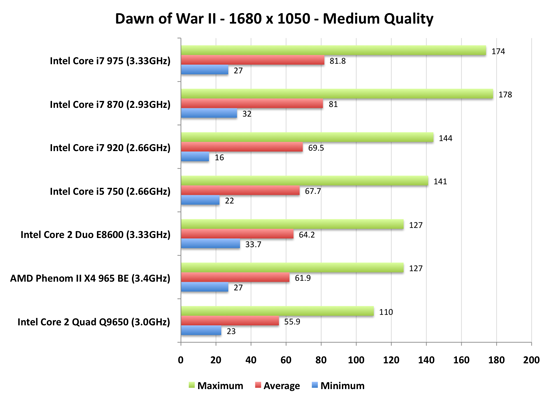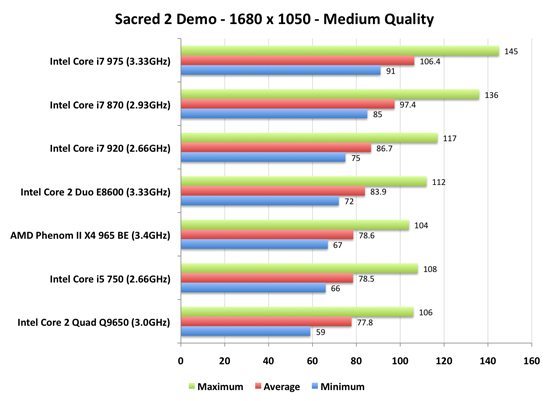Intel's Core i7 870 & i5 750, Lynnfield: Harder, Better, Faster Stronger
by Anand Lal Shimpi on September 8, 2009 12:00 AM EST- Posted in
- CPUs
The Best Gaming CPU?
When I first previewed Lynnfield I theorized that its aggressive turbo modes would make it the best gaming CPU on the market. Most games these days use between two and four threads, not enough for Hyper Threading to be truly beneficial. As a result, Nehalem never really did all that well in games. It was generally faster than the competition, but not much and not on a performance-per-dollar basis.
I ran a few new game tests under Windows 7 to accompany our usual game benchmarks. The competitors here are limited to Lynnfield (of course), Bloomfield, Penryn and AMD's Phenom II.

Dawn of War II doesn't actually shatter any expectations. While turbo clearly benefits Lynnfield, it isn't enough to dethrone Bloomfield. The Core i7 920 is marginally faster than the new i5 750. Here's where things get interesting though: look at minimum frame rates. In both Lynnfield platforms, the minimum frame rates are higher than the competing Bloomfield system. That appears to be Lynnfield's aggressive turbo modes at work. While they're not constantly pushing Lynnfield to a higher clock speed, they do apparently help out when it matters the most.
The other thing to notice is the lowest Lynnfield is a faster gaming CPU than Intel's fastest dual-core: the E8600.

Sacred 2 is an example of performance standings in a more normal manner. Lynnfield can't seem to outperform Bloomfield, and the Core i5 750 actually falls slightly behind AMD's Phenom II X4 965 BE.

With World of Warcraft we're back to turbo mode having a very positive impact. The Core i7 870 is nearly as fast as the i7 975, while the i5 750 is a bit slower than the i7 920. Both are faster than the Phenom II X4 965 BE, which is in turn faster than the Q9650.
These three benchmarks seem to outline the three most realistic options for Lynnfield's gaming performance. In situations where its turbo modes can work, Lynnfield can be equal to if not faster than Bloomfield. In those situations where it doesn't kick in, Lynnfield is at least competitive with Phenom II and Bloomfield. In all situations the old Core 2 Quad Q9650 is at the bottom of the charts.
I'll throw in one more option just to complicate things. Have a look at this:

Not exactly the norm, but here we have the Phenom II X4 965 BE faster than everything - including the Core i7 975. Unfortunately there's no one benchmark that will sum up how these things perform, but overall it looks like Lynnfield is going to be one capable gaming CPU.










343 Comments
View All Comments
nikrusty - Wednesday, November 18, 2009 - link
With this article Anandtech is Harder, Better, Faster Stronger.Seriously AWESOME ARTICLE! It cleared many of my doubts FLAT OUT! Now I know i5 is the way to go especially becoz I dont care about overclocking and just want good gaming performance...nothing screamingly extreme. Budget + Performance always keeps you level headed.
shiro - Wednesday, October 21, 2009 - link
what is that monster hoop of death heatsink that's on page 3? lolEeqmcsq - Saturday, September 19, 2009 - link
I asked a similar question in one of the other articles, so pardon me if this sounds repetitive.According to the Turbo charts, the slowest Turbo speed is higher than the stock speed. Why is that? For example, why not just make the 750 a stock GHz of 2.8 GHz instead of 2.66GHz?
Eeqmcsq - Saturday, September 19, 2009 - link
Argh, please ignore. Replied using the wrong Firefox tab.The0ne - Tuesday, September 15, 2009 - link
Clear up what you're trying to show on the graphs please. You're getting more FPS at max setting than at min settings? Label the graphs like you did with the others please. With the others I can just look and understand what you're doing. With these, I'm scratching my head.The0ne - Tuesday, September 15, 2009 - link
Ah, turbo mode represented in FPS >.>'kkara4 - Monday, September 14, 2009 - link
over at bittech.net, they are saying that it is more worth it to go for the i7-920, if we are considering anything above the i5. this is a conflicting story, since anand is recommending the lynnfields. anand or anybody else for that matter could you please see their articles and tell me what they have done wrong? (or perhaps you guys failed to see something). Your article explains things in great technical detail which i can understand since i have studied microprocessors, hence i am more inclined to go for lynnfield. anyway if someone could cross check that would be goodmapesdhs - Tuesday, September 15, 2009 - link
If I've understood Anand's analysis correctly, the conclusion is that,
for application mixes which involve a lot of single and/or dual-threaded
codes, and assuming one is not interested in high-end SLI/CF setups
or hard oc'ing all 4 cores all the time for tasks like video encoding
or animation rendering, the 750/860 are better buys because they
will internally push 1-core and 2-core clocks to a higher rate than
occurs with the 920 via the Turbo function, giving better results
than the 920, and of course the 750/860 are cheaper solutions
(although the 860 price is similar to the 920, the mbd costs less
than an X58, from what people say).
So it depends on what you want to use your system for. No interest
in CF/SLI? Running games that don't hammer 4 cores? An i5 750 or
i7 860 makes more sense. Using apps that don't use more than 2 cores?
Again the 750/860 is more logical, especially from a cost viewpoint.
This ties in with the other advantage of the X58 platform, ie. the
upgrade path to 6-core and 8-core CPUs. If this is something that
holds no value to you, then P55 makes more sense.
As always, it depends on what you want to use the system for. The
attraction of the 860 from a more general point of view is that it
also offers good quad-core performance when one does use all 4 cores
without sacrificing the traditional higher-clocks possible with
single or dual core setups when one is only using 1 or 2 cores. It's
the best of both worlds, at least for out-of-the-box functionality
anyway.
However, if one does intend to use all 4 cores almost all the time
(I do) with a strong overclock, then the 920 is a better choice
because of the voltage issue and (IMO) the 6/8-core upgrade path.
Likewise, high-end multi-GPU setups work better with X58.
Given that general usage of a PC rarely uses more than 2 cores, this
is why the 750 and 860 are such attractive options.
As for the 870, despite its 1/2-core speed advantages, the price is
too high IMO. For that kind of money, a 920 makes more sense, paired
with better cooling if one has such a spare budget, or buy a better
GPU setup which, for gaming, is where the real bottleneck lies.
Anand, please correct me if I'm wrong with the above.
Ian.
PS. As always, real-world pricing issues can make a mess of on-paper
technical conclusions. Also, although many games/apps don't exploit
more than 2 cores now, this is likely to change in the near future as
multi-core coding becomes more pervasive in the industry.
mapesdhs - Monday, September 14, 2009 - link
Anand/Gary,
Re your comments about an X58 advantage being the ability to use
later 6 and 8-core CPUs...
I've been planning to build an i7 920 system for video encoding, so
a max oc on all cores is useful to me; from the article I thus infer
the X58 is a better choice.
However, if I did buy such a setup instead of an i5 or i7 860, what
would the cost tradeoff be do you think when the 6-core CPUs arrive
with respect to upgrading? By that I mean, for total processing
throughput, do you reckon a 6-core upgrade would be significantly
cheaper than simply buying a second i7 920 setup? (gfx not an issue)
If not, then the ability to use 6/8-core CPUs later in this context
is somewhat lessened, something that would apply to animation
rendering aswell (ie. extra complete systems perhaps more cost
effective in increased overall throughput compared to upgrading to
more cores). Any ideas? Also, unless the applications used can
exploit more than 4 cores, the later 6-core CPUs won't help. I have
about 1500 hours of material to convert to DivX. Each file is about
40 to 45 minutes (documentary), so converting multiple files on
multiple systems at the same time is very doable.
Given the above, I'm looking forward to more details on how a max
oc'd i860/i870 compares to a max oc'd 920.
At present I'm just using a 6000+ setup to work out the appropriate
format/conversion paths.
Ian.
PS. May I suggest you don't bother replying to those moaning in such
an obviously ludicrous manner about the Turbo mode being active? I
have the distinct impression their posts are designed purely to
irritate. Please don't encourage them. Anyone with any sense will
read the article and understand the salient points you've highlighted
about Turbo mode being an integral function of the chip.
Milleman - Sunday, September 13, 2009 - link
I would say that i5 750 and Pehnom II X4 965 is fully comparable. AMD just have to adjust the pricetag and the price/performance will be on par. Looking at the Gaming rig performance, both i5 750 and Pehnom II X4 965 are well enough for gaming pleasure. I wouldn't shell out my bucks for the more expensive Intel top models. It's such a waste of money, unless you are working with huge video and image editing processes.